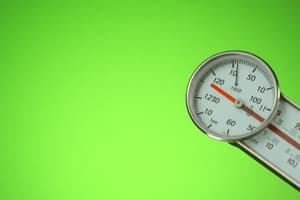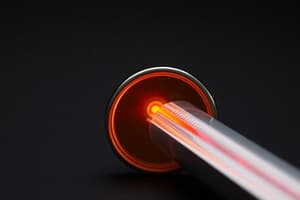Podcast
Questions and Answers
শীতপথকরণ কী?
শীতপথকরণ কী?
- তাপ সংশ্লেষণের ধারণা
- তাপ প্রেরণের ফলাফল
- তাপ প্রসারের ধারণা
- তাপ প্রেরণের প্রক্রিয়া (correct)
আপনার হাতকে একটি জ্বালানির কাছে দিলে। এর ফলে আপনার হাতের ভিতরের অণুরাশির কি ঘটা?
আপনার হাতকে একটি জ্বালানির কাছে দিলে। এর ফলে আপনার হাতের ভিতরের অণুরাশির কি ঘটা?
- নিউক্লিয়ার বিভ্রান্তি
- নিউক্লিয়ার জৈবিক
- নিউক্লিয়ার জ্বালানি (correct)
- নিউক্লিয়ার ঘর্ষন
তাপ ও তাপমাত্রা সাথে ক্ষুদ্রতথ্য সৃষ্টি করে:
তাপ ও তাপমাত্রা সাথে ক্ষুদ্রতথ্য সৃষ্টি করে:
- নিউক্লিয়ার (correct)
- নিউরন
- নিউট্রন
- নিউডাইনামিক
শীত ।
শীত ।
_ _ এর _ _ _ ?
_ _ এর _ _ _ ?
?
?
থার্মোমিটার কি উপযুক্ত তাপমাত্রা প্রদর্শনের উপকরণ?
থার্মোমিটার কি উপযুক্ত তাপমাত্রা প্রদর্শনের উপকরণ?
কেন থার্মোমিটার একটি উপযুক্ত তাপ প্রদর্শনের উপকরণ?
কেন থার্মোমিটার একটি উপযুক্ত তাপ প্রদর্শনের উপকরণ?
নিচের কোনটি শীত পোড়ানের উপায়?
নিচের কোনটি শীত পোড়ানের উপায়?
Study Notes
Understanding Temperature and Thermometry in Bengali Contexts
Temperature is a fundamental concept across various scientific disciplines, including physics, chemistry, biology, engineering, and meteorology. In our daily lives, we interact with temperature constantly—be it adjusting room thermostats, measuring food cooking temperatures, or observing weather patterns. In this exploration of তাপ ও তাপমাত্রা, let's delve into the concepts of heat transfer, temperature measurement, small quantities of thermal energy (ক্ষুদ্রতথ্য), temperature regulation, and temperature scales.
Heat Transfer and Shītapathakaran (Heat Generation)
When an object absorbs or emits radiant energy due to differences in its internal kinetic activity, such as molecular motion or rotational movement, we observe changes in temperature known as heat exchange. This phenomenon is commonly referred to as শীতপথকরণ. For instance, when you hold your hand near a fire source, it warms up because the molecules inside your skin gain kinetic energy from the radiation absorbed. Conversely, if you place something hot outdoors on a chilly day, the surrounding air will absorb some of that excess heat, cooling down both objects.
Temperature Measurement and Sanskriti (Methods)
To accurately measure temperature, scientists developed several methods over time. One widely used method today is based on the expansion behavior of liquids like mercury or alcohol in closed containers called thermometers. These devices display numerical values corresponding to specific temperatures through different lengths of liquid columns. Other common methods involve the use of resistance thermometers (RTDs), thermistors, and thermocouples that output electrical signals proportional to the measured temperature.
Microscopic Quantities of Thermal Energy—Kshudrathtya
Even minute amounts of heat can cause substantial changes. Let's consider chemical reactions: When reactants collide with enough kinetic energy (heat), they may form products according to their reaction enthalpy. Similarly, the human body generates heat internally via cellular metabolism processes; too little or too much heat can lead to health issues like hypothermia or hyperthermia.
Regulating Temperature—Preran
In nature, maintaining a stable temperature level is crucial for many organisms' survival. Animals utilize various strategies such as sweat glands, feathers, fur, hair, or specialized vascular systems within their bodies to regulate their core temperature. Plants also have mechanisms to manage their physiological responses by altering transpiration rates and leaf area depending upon external environmental stimuli. As humans, we control indoor environments using heating and cooling systems while wearing clothing appropriate for prevailing climates.
Temperature Scales and Skala (Scale)
A standardized scale helps us compare temperatures conveniently. We primarily use three such scales: Celsius, Fahrenheit, and Kelvin. Each scale represents temperature differently, yet all follow a consistent relationship among them. Common conversions between these scales exist, allowing one to communicate temperatures worldwide without confusion. It's essential to understand the zero points of each scale since the boiling point and freezing points are set accordingly.
It's worth noting that, although this discussion focuses on scientific perspectives, acknowledging everyday experiences and cultural interpretations when discussing temperature and temperature scales enriches our understanding significantly.
Studying That Suits You
Use AI to generate personalized quizzes and flashcards to suit your learning preferences.
Description
Explore the fundamental concepts of temperature, heat transfer, temperature measurement methods, microscopic thermal energy, temperature regulation in organisms, and temperature scales. Discover how these concepts apply in various scientific disciplines and daily life activities in the context of তাপ ও তাপমাত্রা.




